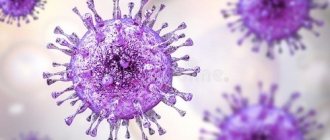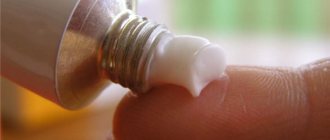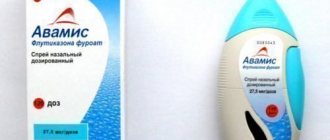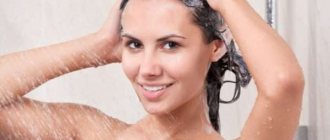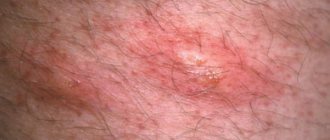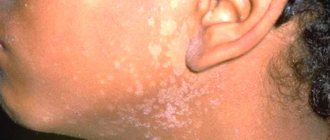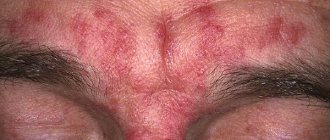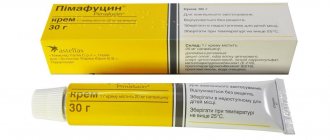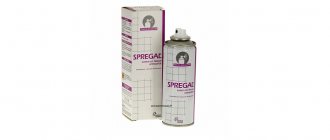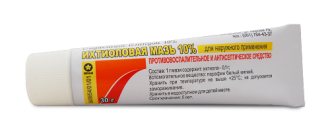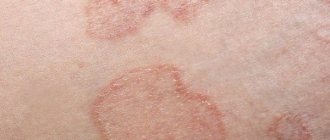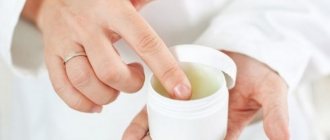Local treatment of pityriasis versicolor includes a series of procedures aimed at suppressing the vital activity of the yeast-like fungus and eliminating the unpleasant symptoms of the disease.
Dermatologists recommend using sprays to treat the skin - they are easy to use, rarely cause side effects and have a beneficial effect on the condition of the skin, helping to cleanse it of scales and crusts.
Causes of pityriasis versicolor
As mentioned above, tinea versicolor is caused by yeast-like fungi. They are called Pityrosporum orbiculare. In most cases, this fungus becomes active in people aged 14–40 years, and is practically never found in preschool children. The fungus begins to actively multiply due to the following factors:
- excessive sweating due to hot climate, infectious disease;
- neglect of personal hygiene;
- diseases of the endocrine system, gastrointestinal tract, diabetes mellitus;
- VSD, including in adolescents;
- reduced immunity, taking glucocorticoids, cytostatics.
You can get infected from a sick person, but even if the fungus gets on the skin, it will provoke the disease only under accompanying conditions.
Symptoms of pityriasis versicolor
Doctors note a surge in the disease between April and June. Relapses are also possible in women during pregnancy and taking oral contraceptives. There are different symptoms that characterize lichen versicolor; the active manifestation of lichen versicolor looks like spots and rashes, flaky areas of the skin. Skin areas on the abdomen, back, chest and neck are most often affected. Rarely, tinea versicolor appears in the armpits and groin, inside the thighs and on the head.
The initial symptoms are yellowish dots, which over time grow into pink spots with a diameter of 1 cm. Over time, the spots turn brown and brown. It is this difference in the colored areas that gives the disease its name “variegated, colored” lichen.
It was named pityriasis versicolor because of the flaky scales that resemble bran. Itching with this form of lichen is rare and can be experienced by people who sweat frequently. It takes a long time to treat the disease with tablets and ointments; even when taking effective drugs, relapses cannot be ruled out.
Etiology
The causative agents of pityriasis versicolor are the fungi Pityrpsporum orbiculare and Malassezia furfur, which infect the stratum corneum of the epidermis, growing under the skin in the form of clusters of curved thick threads. The following factors can contribute to the development of dermatomycosis, which belongs to the group of conditionally contagious pathologies:
- hereditary predisposition;
- climate characteristics (the disease becomes more active and worsens in conditions of high temperature and air humidity);
- an imbalance of physiological processes in the stratum corneum of the epidermis (with increased production of sebum and changes in its chemical composition, rapid development of the disease is observed);
- hyperhidrosis (increased sweating promotes activation of fungal microflora);
- the presence of concomitant pathologies (tuberculosis, obesity, neuroses, vegetative-vascular disorders, diabetes mellitus, diseases of the endocrine, digestive and respiratory systems);
- weakened immune system;
- excessively frequent cleansing of the skin with antibacterial cosmetics (soaps, gels, etc.), which violate the natural protective layer of the epidermis.
The manifestations of the disease most often affect men in adolescence, young adulthood and adulthood. In women, dermatomycosis can develop due to diseases of the ovaries and adrenal glands, against the background of hormonal changes during puberty, pregnancy or menopause.
Diagnosis of lichen versicolor
Vivid symptoms clearly indicate the presence of the disease, but the doctor must differentiate tinea versicolor from other dermatological diseases with a similar picture. Basic diagnostic methods:
- Examination of skin scrapings under a microscope to identify fungus.
- Balzer's test for hidden peeling.
- Using a Wood's lamp, in the light of which the ringworm glows yellow or brown.
The listed methods will allow you to distinguish pityriasis versicolor from such skin diseases as:
- syphilitic roseola, characterized by spots of the same size that do not merge together, unlike pityriasis versicolor spots;
- pink lichen of Zhiber, characterized by the presence of a “maternal” plaque and bright pink spots;
- syphilitic leukoderma, the signs of which are white spots with a delineated contour;
- dry streptoderma, during which single, fairly large, light-colored spots form on the skin.
Treatment of ringworm
It is not recommended to choose pills for tinea versicolor on your own for yourself or a loved one, since each medicine has contraindications. If treated incorrectly, the remedy can worsen the patient’s condition, and the disease will enter the chronic stage. The doctor prescribes effective medications based on the patient’s general condition and the course of the disease. Complex treatment also includes nutritional correction. You need to eat more dairy products and fiber-rich vegetables. Strong broths, sweets, chocolate, canned food, and smoked foods should be limited.
For pityriasis versicolor, treatment is carried out with antimycotic and keratolytic drugs. Each product is selected individually. If a small area of skin is affected, the doctor prescribes local medications. It can be:
- Mycozoral (Ketoconazole) is an ointment that is applied once a day for 2-3 weeks;
- Clotrimazole is a solution that needs to be rubbed into the foci of the disease for 1-3 weeks;
- Terbinafine - a cream that is rubbed into the affected skin twice a day for 2 weeks;
- Ciclopirox is a solution or cream that is used to treat the skin twice a day. Course – 10 days.
To make the treatment more effective, dermatologists recommend treating not only obvious lesions of lichen with ointments and solutions, but also applying the preparations to the surrounding skin.
As a rule, these medications are well tolerated. In some cases, adverse reactions may occur - burning and redness of the skin, individual intolerance. It is important to consider that treatment with local agents is not carried out during the 1st trimester of pregnancy. If a woman is breastfeeding, the doctor will evaluate the appropriateness of prescribing medications. In this case, alternative methods of combating the fungus may be recommended, namely treatment with:
- rubbing benzyl benzoate solution once a day for 5 days. Adults are prescribed a 20% solution, children – 10%;
- applying sulfur-salicylic ointment;
- treatment of deprivation lesions with a 60% aqueous solution of sodium hyposulfate, followed by a 6% solution of hydrochloric acid.
The only advantage of the listed methods is that they are prescribed when antifungal agents cannot be prescribed for some reason. Otherwise, these products are already considered outdated, and are often fraught with itching and burning at the sites of application.
Shampoos
To combat fungal infections on the scalp, it is recommended to use shampoos. With regular use, the product can relieve the patient from the unpleasant symptoms of the disease in a short time.
The following remedies have shown themselves to be effective in the treatment of lichen:
- Sebozol.
- Exoderm.
- Keto-plus.
- Sulsena.
- Skin cap.
Each shampoo with an antifungal effect has its own characteristics of use and contraindications, which are important to consider before starting the procedure.
Pityriasis versicolor tablets
Modern medications used to treat tinea versicolor have a common name - systemic antimycotics. These can be tablets or capsules. Fluconazole and Itraconazole are often prescribed. Fluconazole is usually taken 150 mg once a week. The course lasts 1-2 months depending on the severity of the disease. Itraconazole is taken 100 mg once a day for 15 days or 200 mg per day for a week. The specific dosage will be indicated by the attending physician - infectious disease specialist, dermatologist.
It is important to understand that you should not take systemic medications on your own. They can give the following adverse reactions:
- inhibition of hematopoiesis;
- disturbances in heart rhythm;
- allergies, including Lyell's syndrome;
- negative effect on the central nervous system - dizziness, fatigue, headaches;
- malfunction of the gastrointestinal tract - bloating, nausea and vomiting, decreased appetite, changes in taste, loose stools.
These side effects are not always observed, but they are worth knowing about. As well as about contraindications. This may be individual intolerance to the components of the drug, age under 4 years, QT prolongation on the cardiogram. With caution, systemic tablets for lichen are prescribed for kidney and liver diseases, pregnancy, alcoholism, and heart disease. There is no point in prescribing antibiotics - they are not effective against fungus.
At home, in parallel with drug therapy, you can use folk remedies for tinea versicolor. This is boric or salicylic acid. They treat the foci of the disease twice a day for a week. The effect will be better if after such treatment you apply an ointment or cream against the fungus.
During pregnancy, pityriasis versicolor does not cause harm to the fetus, only aesthetic discomfort to the mother. External agents are used for treatment. For example, dermatologists recommend using a “talk” made from glycerin, zinc oxide, water and alcohol, talc and starch. This solution is called "Tsindol". A cotton swab is dipped into it, then the areas of skin affected by lichen are generously blotted. This is done three times a day. The chatterbox has an anti-inflammatory, disinfecting effect, dries the skin, and relieves allergic reactions. There are no adverse reactions to it.
Treating yourself at home with celandine
When infected with tinea versicolor, the skin becomes covered with rashes of rich color and varying sizes. They look unattractive and frighten others, although they are not transmitted through household contact.
Antihistamines used in combination with traditional healers can help eliminate the problem. Timely comprehensive therapy will allow you to get rid of the disease without the risk of its rapid return.
When treating versicolor with folk remedies, many healers advise using celandine. An infusion of this medicinal plant helps eliminate colored spots on the skin in a fairly quick time. It is prepared according to the following recipe:
- chop the dried herb thoroughly using a well-sharpened knife, mix with sugar in the proportion: 1 cup of celandine to 1 cup of sugar;
- wrap the resulting mixture in gauze and carefully lower it into a 3-liter jar;
- Heat the yogurt over a fire until it boils and pour it into the same jar with celandine in gauze;
- the product is infused for 28 days, after which it is used internally.
On a note! Over time, the surface of the tincture becomes covered with a light foam, which is important to carefully remove using a slotted spoon.
After 28 days, the yogurt is drained, covered with a lid and placed in the refrigerator. Drink 50 grams of infusion 3 times a day before meals.
Prevention of ringworm
For the purpose of prevention, it is necessary to observe hygiene measures and promptly treat diseases of the gastrointestinal tract, endocrine and nervous systems. Patients who have once had lichen should refrain from visiting public swimming pools, saunas and baths. It is also better for them not to travel to hot countries, since the climate can provoke illness.
If there is a sick person in the family, you need to protect other family members from infection. To do this, the patient’s bed linen and underwear are boiled in a soda-soap solution. You can simply wash your clothes in an automatic machine at high temperatures, and then iron them with a hot iron and steam.
Moderate tanning helps protect against recurrences of lichen. In direct sunlight, the fungus dies. Also, for prevention in the spring, you need to use Ketoconazole shampoo. It is enough to apply it once a month to damp skin and hold for 5 minutes, then rinse with warm water.
The patient can learn about complete recovery from the doctor after submitting the scraping for microscopic examination. If no fungal particles are detected, we can say that the disease has been successfully defeated.
